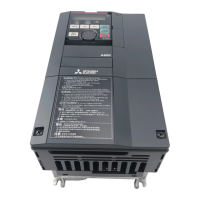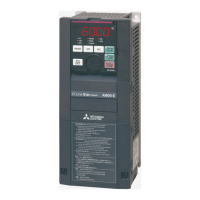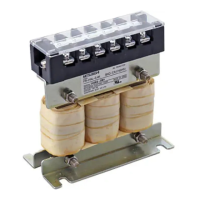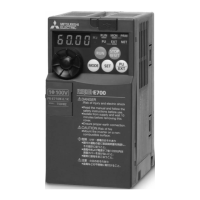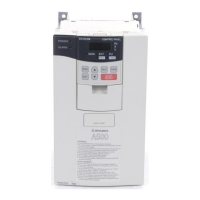69
4.13 Operation setting at fault occurrence 154
4.13.1 Retry function (Pr. 65, Pr. 67 to Pr. 69) ................................................................................................................... 154
4.13.2 Fault code output selection (Pr. 76)......................................................................................................................... 156
4.13.3 Input/output phase loss protection selection (Pr. 251, Pr. 872) ............................................................................. 157
4.14 Energy saving operation and energy saving monitor 158
4.14.1 Energy saving control and Optimum excitation control (Pr. 60)............................................................................. 158
4.14.2 Energy saving monitor (Pr. 891 to Pr. 899)............................................................................................................. 159
4.15 Motor noise, EMI measures, mechanical resonance 164
4.15.1 PWM carrier frequency and Soft-PWM control (Pr. 72, Pr. 240, Pr. 260)............................................................. 164
4.15.2 Speed smoothing control (Pr. 653, Pr. 654)............................................................................................................ 165
4.16 Frequency setting by analog input (terminal 1, 2, 4) 166
4.16.1 Analog input selection (Pr. 73, Pr. 267)................................................................................................................... 166
4.16.2 Analog input compensation (Pr. 73, Pr. 242, Pr. 243, Pr. 252, Pr. 253)................................................................ 170
4.16.3 Response level of analog input and noise elimination (Pr. 74).............................................................................. 171
4.16.4 Bias and gain of frequency setting voltage (current)
(Pr. 125, Pr. 126, Pr. 241, C2(Pr. 902) to C7(Pr. 905)).......................................................................................... 172
4.16.5 4mA input check of current input (Pr. 573, Pr. 777, Pr. 778) ................................................................................. 177
4.17 Misoperation prevention and parameter setting restriction 181
4.17.1 Reset selection/disconnected PU detection/PU stop selection (Pr. 75)................................................................ 181
4.17.2 Parameter write selection (Pr. 77)........................................................................................................................... 184
4.17.3 Reverse rotation prevention selection (Pr. 78)........................................................................................................ 185
4.17.4 Display of applied parameters and user group function (Pr. 160, Pr. 172 to Pr. 174) .......................................... 185
4.17.5 Password function (Pr. 296, Pr. 297) ...................................................................................................................... 187
4.18 Selection of operation mode and operation location 190
4.18.1 Operation mode selection (Pr. 79) .......................................................................................................................... 190
4.18.2 Operation mode at power ON (Pr. 79, Pr. 340)...................................................................................................... 198
4.18.3 Start command source and speed command source during
communication operation (Pr. 338, Pr. 339, Pr. 550, Pr. 551)............................................................................... 199
4.19 Communication operation and setting 204
4.19.1 Wiring and configuration of PU connector .............................................................................................................. 204
4.19.2 Wiring and arrangement of RS-485 terminals ........................................................................................................ 206
4.19.3 Initial settings and specifications of RS-485 communication
(Pr. 117 to Pr. 124, Pr. 331 to Pr. 337, Pr. 341, Pr. 549)........................................................................................ 209
4.19.4 Communication EEPROM write selection (Pr. 342)............................................................................................... 211
4.19.5 Operation selection at communication error (Pr.502, Pr.779)................................................................................ 211
4.19.6 Mitsubishi inverter protocol (computer link communication) .................................................................................. 214
4.19.7 Modbus-RTU communication specifications
(Pr. 331, Pr. 332, Pr. 334, Pr. 343, Pr. 502, Pr. 539, Pr. 549, Pr.779)................................................................... 227
4.19.8 BACnet MS/TP protocol........................................................................................................................................... 242
4.19.9 Operation by PLC function
(Pr. 414, Pr. 415, Pr. 498, Pr. 506 to Pr. 515, Pr. 826 to Pr. 865).......................................................................... 255
4.20 PID control 256
4.20.1 Outline of PID control (Pr. 127 to Pr. 134, Pr. 241, Pr. 553, Pr. 554,
Pr. 575 to Pr. 577) .................................................................................................................................................... 256
4.20.2 Bias and gain calibration for PID displayed values
(Pr. 241, Pr. 759, C42(Pr. 934) to C45(Pr. 935)).................................................................................................... 268
4.20.3 Pre-charge function (Pr.760 to Pr. 769) .................................................................................................................. 270
4.20.4 Second PID function (Pr.753 to Pr. 758, Pr.765 to Pr.769) ................................................................................... 275
4.20.5 Advanced PID function (pump function) (Pr. 554, Pr. 575 to Pr. 591)................................................................... 277
4.21 Special operation and frequency control 287
4.21.1 Bypass-inverter switchover function (Pr. 57, Pr. 58, Pr. 135 to Pr. 139, Pr. 159) ................................................. 287
4.21.2 Traverse function (Pr. 592 to Pr. 597)..................................................................................................................... 292
4.21.3 Regeneration avoidance function (Pr. 665, Pr. 882 to Pr. 886) ............................................................................. 294
4.22 Useful functions 296
4.22.1 Cooling fan operation selection (Pr. 244)................................................................................................................ 296
4.22.2 Display of the life of the inverter parts (Pr. 255 to Pr .259)..................................................................................... 297
4.22.3 Maintenance timer alarm (Pr. 503, Pr. 504)............................................................................................................ 300
4.22.4 Current average value monitor signal (Pr. 555 to Pr. 557)..................................................................................... 301
4.22.5 Free parameter (Pr. 888, Pr. 889) ........................................................................................................................... 303
